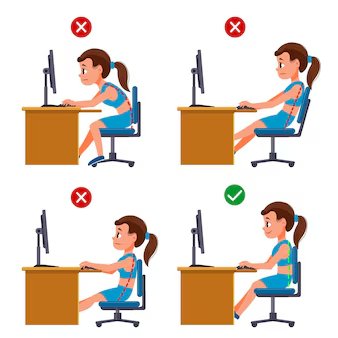Back
Why Sitting Can Cause Neck Pain and How to Fix It
By Shannon Strauch, PTA, STMT-1 on 4/24/2024

Introduction
: Sitting for extended periods, whether at a desk, in front of a computer, or even while driving, is a common modern-day activity. Unfortunately, this seemingly harmless habit can lead to various health issues, including neck pain. Understanding why sitting contributes to neck pain and learning how to address it can significantly improve your overall well-being. In this blog post, we'll explore the reasons behind neck pain from sitting and provide practical tips to alleviate and prevent this discomfort.Why Sitting Leads to Neck Pain:
Poor Posture: One of the primary reasons sitting causes neck pain is poor posture. When we sit for long periods without proper support for our spine and neck, it can lead to slouching, forward head posture, and strain on the neck muscles.
Muscle Imbalance: Sitting for hours on end can create muscle imbalances, especially in the neck and upper back. The muscles at the front of the neck may become tight and overactive, while the muscles in the back of the neck and upper back may weaken and become prone to strain.

Reduced Blood Flow: Prolonged sitting can also reduce blood flow to the neck muscles, leading to stiffness, tension, and discomfort.
Increased Stress on the Spine: Sitting places increased stress on the spine, especially in the cervical (neck) region. This can exacerbate existing neck issues or create new ones over time.

How to Fix and Prevent Neck Pain from Sitting:
Practice Proper Ergonomics: Adjust your workstation to promote good posture. Ensure your computer screen is at eye level, your chair supports your lower back, and your feet are flat on the floor or on a footrest. Use ergonomic tools like a supportive chair or an adjustable desk if possible.
Take Regular Breaks: Incorporate regular breaks into your sitting routine. Stand up, stretch, and walk around every 30 minutes to an hour. This helps relieve muscle tension and improves circulation.
Strengthen and Stretch: Incorporate neck and upper back exercises into your routine to strengthen weak muscles and improve flexibility. Examples include neck stretches, shoulder rolls, and upper back extensions.
Mind Your Posture: Be mindful of your posture throughout the day, whether sitting, standing, or walking. Keep your spine aligned, shoulders relaxed, and head in a neutral position rather than jutting forward.
Use Proper Support: Consider using ergonomic supports such as a supportive pillow or cushion for your lower back and neck while sitting. This helps maintain proper alignment and reduces strain.
Stay Active: Engage in regular physical activity to keep your muscles strong and flexible. Activities like yoga, Pilates, and strength training can complement your efforts to prevent neck pain from sitting.
Conclusion
: Neck pain from sitting is a common issue in today's sedentary lifestyle. By understanding the reasons behind it and implementing practical strategies such as proper ergonomics, regular breaks, strengthening exercises, and mindful posture, you can effectively alleviate and prevent neck pain, promoting better overall health and well-being.Read More:
Dry Needling for C-Section Scars and Postpartum Recovery By Dr. Christine Martirez PT, DPT on 10/15/2024 Learn how dry needling can be used for c-section scars and c-section recovery How Red Light Therapy Can Be Used to Treat Pelvic Floor Dysfunctions By Dr. Christine Martirez PT, DPT on 10/15/2024 Learn about red light therapy and how it can be used to treat pelvic floor dysfunctions
Are you ready to live pain free?
Request An Appointment